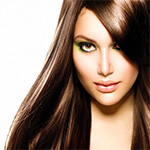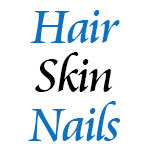- Abnormal hair loss, alopecia, alopecia areata, androgenetica alopecia, bald, balding, baldness, bleaching, body hair, coarse hair, depilatory, electrolysis, facial hair, hair, hair growth, hair loss, hair restoration, hair transplant, hyperandrogenism, hypertrichosis, ingrown hair, laser therapy, plucking, shaving, threading, telogen effluvium, waxing, white hair, wig.
|
Background
- Hair disorders may occur when excessive amounts of hair grow or fall out. They may also occur if the hair lacks pigment in certain areas or if the hair becomes gray prematurely. These conditions can be temporary or permanent, depending on the cause.
- There are many potential causes of hair disorders, ranging from immune disorders and genetics to illnesses and medications. For many, abnormal hair loss or growth is not a major health concern, although some individuals may feel self conscious or have a difficult time coping with their appearances. Sometimes a hair disorder is a sign of an underlying health condition, such as a nutrient deficiency, a hormonal disorder (such as an adrenal disorder), metabolic disturbances, or a fungal infection of the scalp.
- In healthy individuals, hair of varying length and thickness grows all over the body except for the palms of the hands, soles of the feet, and lips. Most of the hairs on the scalp do not grow individually. Instead, they grow in clusters, called follicular units, of 1-5 hairs. Each hair has its own oil gland.
- It generally takes about four months for healthy hair (on the head) to grow one inch. Most hairs on the head grow 4-6 years before falling out. In contrast, hair on the arms, legs, eyelashes, and eyebrows only grows for about 30-45 days, which is the hair is so much shorter than the hair on the scalp.
- It is normal for some hair to fall out each day. It is estimated that adults lose 50-150 hairs on the head each day. Once a hair falls out, new hair grows in its place. Hair growth may be less noticeable in patients with curly hair or in people with lighter-colored hair. As individuals age, most people experience hair thinning or loss. It is also common for the hair to become gray or white and dry, coarse, and/or wiry.
|
Integrative therapies
-
Unclear or conflicting scientific evidence:
- Aromatherapy: Aromatherapy refers to many different therapies that use essential oils. The oils are sprayed in the air, inhaled, or applied to the skin. Essential oils are usually mixed with a carrier oil, usually a vegetable oil or alcohol. The carrier oil dilutes the essential oil before it is applied to the skin. Massage is often used to deliver oils into the body because it is considered the most effective method. A well-designed human study in patients with alopecia areata examined the effects of massaging a mixture of essential oils into the scalp daily for seven months. The mixture included oils of cedarwood, lavender, rosemary, and thyme in carrier oils of grapeseed and jojoba. A significant improvement was seen in photographs of the skin of patients using the mixture of oils compared to patients using carrier oils alone. Although these results are promising, further research is needed before a firm conclusion can be made.
- Essential oils should be administered in a carrier oil to avoid toxicity. Avoid with a history of allergic dermatitis. Avoid consuming essential oils orally. Avoid direct contact of undiluted oils with mucous membranes. Use cautiously if driving/operating heavy machinery. Use cautiously with asthma, bronchitis, emphysema, epilepsy, or migraine headaches. Sage, rosemary, and juniper oils may cause the uterus to contract when taken in large amounts. Due to these reports, and lack of reliable safety data the use of these oils, they are discouraged during pregnancy.
- Beta-sitosterol: Beta-sitosterol is found in plant-based foods, such as fruits, vegetables, soybeans, breads, peanuts, and peanut products. It is also found in bourbon and oils, such as olive oil, flaxseed, and tuna. Early human research suggests that beta-sitosterol may help treat androgenetic alopecia. However, further research is needed to determine whether or not this treatment is safe and effective in humans.
- Avoid if allergic or hypersensitive to beta-sitosterol, beta-sitosterol glucoside, or pine. Use cautiously with asthma, breathing disorders, diabetes, primary biliary cirrhosis (destruction of the small bile duct in the liver), ileostomy, neurodegenerative disorders (such as Parkinson’s disease or Alzheimer’s disease), bulging of the colon, short bowel syndrome, celiac disease, or sitosterolemia. Use cautiously with a history of gallstones. Avoid if pregnant or breastfeeding.
- Cedar: Cedar is native to the mountains of the western Himalayan region and the Mediterranean. In clinical study, patients with alopecia areata who were massaged with a combination of cedarwood oil, other aromatic oils, and carrier oils had significantly improved symptoms. Additional studies using cedarwood oil as a monotherapy are needed before a recommendation can be made.
- Avoid if allergic or hypersensitive to cedar, cedar pollen, wood dust, constituents, or members of the Pinaceae family. Avoid if pregnant or breastfeeding.
- Hypnosis, hypnotherapy: Hypnosis is a trance-like state in which a person becomes more aware and focused and is more open to suggestion. Hypnotherapists commonly divide therapy into pre-suggestion, suggestion, and post-suggestion phases. Hypnotherapy has been used to treat health conditions or to change behaviors. Based on early research, hypnosis may help improve psychological well-being and physiological outcome in patients with alopecia areata. Larger, well-designed studies are needed before a firm conclusion can be drawn.
- Use cautiously with mental illnesses, such as psychosis/schizophrenia, manic depression, multiple personality disorder, or dissociative disorders. Use cautiously with seizure disorders.
- Lavender: Lavender is grown around the world. Oils from the flowers are used in aromatherapy, baked goods, candles, cosmetics, detergents, jellies, massage oils, perfumes, powders, shampoo, soaps, and teas. Small studies have shown that patients who massage essential oils (thyme, rosemary, lavender, and cedarwood) into their scalps daily experienced an improvement in alopecia. More research of lavender alone is needed to make a conclusion.
- Avoid if allergic or hypersensitive to lavender. Avoid with a history of seizures, bleeding disorders, eating disorders (anorexia, bulimia), or anemia (low levels of iron). Avoid if pregnant or breastfeeding.
- Onion: Preliminary study using topical onion juice increased hair regrowth in patients with alopecia areata, especially women. More research is needed to confirm these results.
- Avoid if allergic or hypersensitive to onion (Allium cepa), its constituents, or members of the Lilaceae family. Use cautiously with hematologic (blood) disorders, diabetes, hypoglycemia (low blood sugar), and hypotension (low blood pressure). Use cautiously if taking anticoagulants or antiplatelets (blood thinners). Avoid if pregnant or breastfeeding in medicinal doses.
- Para-aminobenzoic acid: Pantogar®, a formulation containing B vitamins, calcium-d-pantothenate, vigar yeast, L-cystine, keratin, and para-aminobenzoic acid, has been studied in the treatment of hair loss, structural hair lesions, early alopecia, and dystrophy of nails. Additional clinical study is needed before a firm conclusion can be made.
- Avoid with known hypersensitivity to PABA or its derivatives. Avoid oral use in children and pregnant or nursing women. Use cautiously in patients with renal disease, bleeding disorders or taking anticoagulants, diabetics or patients at risk for hypoglycemia. Discontinue use if rash, nausea, or anorexia occurs. Pharmaceutical doses of PABA and its derivatives should only be taken under appropriate medical supervision. PABA should not be given concurrently with sulfonamides.
- Rosemary: Rosemary (Rosmarinus officinalis Linn.) is a common evergreen aromatic shrub that is grown in many parts of the world. The fresh and dried leaves are used frequently in traditional Mediterranean foods as a flavoring agent and as a food preservative. Historically, rosemary has been used to stimulate the growth of hair. In early study, rosemary oil has been shown to increase circulation and possibly promote hair growth in patients with alopecia areata. Additional study is warranted to confirm these findings.
- Avoid if allergic or hypersensitive to rosemary, its constituents, or members of the Labitae/Lamiaceae family. Use cautiously if prone to atopic or hypersensitivity reactions. Use cautiously with a history of iron deficiency anemia. Use cautiously with coagulation disorders, hypotension, diabetes, or peptic ulcer disease. Use cautiously if taking anticoagulants, antiplatelet agents, anti-hypertensive agents, anti-cancer drugs, medication for high cholesterol, herbs or drugs that are broken down by the liver, diuretics, estrogen or estrogenic herbs, or medications for osteoporosis. Avoid if taking lithium. Avoid if pregnant or breastfeeding.
- Saw palmetto: Saw palmetto (Serenoa repens or Sabal serrulata) is commonly used in Europe to treat symptoms of enlarged prostate. It has been suggested that saw palmetto may reduce androgenetic alopecia (inherited hair loss) in men and women, similar to the medication finasteride (Propecia®). More studies are necessary before saw palmetto can be recommended for this use.
- Avoid if allergic or hypersensitive to saw palmetto. Use cautiously with a history of health conditions involving the stomach, liver, heart, or lungs; hormone-sensitive conditions; or bleeding disorders. Use cautiously with drugs that thin the blood, hormonal drugs, or birth control pills. Avoid if pregnant, possibly pregnant, or thinking about becoming pregnant. Avoid if breastfeeding.
- Selenium: Selenium is a trace mineral found in soil, water, and some foods. Studies report that selenium-containing shampoos may help improve dandruff and selenium is included in some commercially available products.
- Avoid if allergic or sensitive to products containing selenium, such as Selsun Blue® or Head and Shoulders Intensive Treatment Dandruff Shampoo®. Avoid with a history of non-melanoma skin cancer. Selenium is generally regarded as safe for pregnant or breastfeeding women. However, animal research reports that large doses of selenium may lead to birth defects.
- Tea tree oil: The tea tree (Melaleuca alternifolia) is a small tree with narrow, soft, alternate leaves and yellowish flowers the shape of bottlebrushes. It is one of more than 30 species of paperbark trees that are found throughout Australia. Tea tree oil is obtained by steam distillation of the leaves of the tea tree. Preliminary research shows that the use of 5% tea tree oil shampoo for mild-to-moderate dandruff may be effective and well tolerated. Further research is needed to confirm these results.
- Avoid use if allergic to tea tree oil or plants of the Myrtle (Myrtaceae) family, Balsam of Peru, or banzoin. Use cautiously with a history of eczema. Avoid taking tea tree oil by mouth because cases of toxicity have been reported. Avoid if pregnant or breastfeeding.
- Thyme: Thyme is a common herb used in cooking. It has also been used for thousands of years to treat various medical conditions. Thyme has been suggested as a possible treatment for alopecia areata, however, further research is needed to confirm these claims.
- Avoid if allergic or hypersensitive to thyme, constituents of thyme, members of the Lamiaceae (mint) family, or rosemary (Rosmarinus officinalis). Avoid oral ingestion or non-diluted topical application of thyme oil due to potential toxicity. Symptoms of reported toxic reactions range from nausea to respiratory arrest. Avoid topical preparations in areas of skin breakdown or injury or in atopic patients, due to multiple reports of contact dermatitis. Use cautiously with gastrointestinal irritation or peptic ulcer disease, due to anecdotal reports of gastrointestinal irritation. Use cautiously with thyroid disorders due to observed anti-thyrotropic effects in animal research of the related species Thymus serpyllum. Avoid if pregnant or breastfeeding.
- Thymus extract: Thymus extracts for nutritional supplements are usually derived from young calves (bovine). Thymus extract is commonly used to treat primary immunodeficiencies, bone marrow failure, autoimmune disorders, chronic skin diseases, recurrent viral and bacterial infections, hepatitis, allergies, chemotherapy side effects, and cancer. Preliminary evidence suggests that thymus extract may be useful for hair re-growth. More clinical trials are required before recommendations can be made for use of thymus extract for alopecia.
- Avoid if allergic or hypersensitive to thymus extracts. Use bovine thymus extract supplements cautiously due to potential for exposure to the virus that causes “mad cow disease.” Avoid use with an organ transplant or other forms of allografts or xenografts. Avoid with thymic tumors, myasthenia gravis (neuromuscular disorder), or untreated hypothyroidism. Avoid if receiving immunosuppressants or hormonal therapy. Avoid if pregnant or breastfeeding. Thymic extract increases human sperm motility and progression.
- Zinc: A few studies that examined the efficacy of oral zinc for the treatment of alopecia reported contradictory results. Additional studies are needed before a conclusion can be made. In addition, shampoo containing 1% of zinc pyrithione has been shown to reduce dandruff in some patients. For instance, Head & Shoulders Pyrithione Zinc Dandruff Shampoo® contains 1% of zinc pyrithione.
- Zinc is generally considered safe when taken at the recommended dosages. Avoid zinc chloride since studies have not been done on its safety or effectiveness. While zinc appears safe during pregnancy in amounts lower than the established upper intake level, caution should be used since studies cannot rule out the possibility of harm to the fetus.
|
Prevention
- There is currently no known method of prevention of alopecia areata, androgenetica alopecia, or hair loss that is caused by aging.
- Patients who are concerned that certain medications may lead to hair loss should talk to their healthcare providers. It may be possible for the patient to take a different drug or dose of the medication to prevent or reduce symptoms of hair loss.
- Patients should maintain healthy and well-balanced diets because poor nutrition may lead to temporary hair loss.
- Patients using hair treatments, such as hair dye, should do so with caution.
- Most cases of hirsutism cannot be prevented. However, women with polycystic ovary syndrome can reduce their risk of developing the disorder by properly managing obesity and preventing insulin resistance.
|
Author information
- This information has been edited and peer-reviewed by contributors to the Natural Standard Research Collaboration (www.naturalstandard.com).
|
Bibliography
- American Academy of Dermatology. .
- American Hair Loss Association. .
- Dawber RP. Guidance for the management of hirsutism. Curr Med Res Opin. 2005 Aug;21(8):1227-34.
- Hair Loss Information Center. .
- Heid E, Bekkali A, Lazrak B, et al. [Neurofibroma, poliosis and vitiligo.] [Article in French.] Ann Dermatol Venereol. 1978 Jun-Jul;105(6-7):645-6.
- Natural Standard: The Authority on Integrative Medicine. .
- [No authors listed.] Does eflornithine help women face hirsutism? Drug Ther Bull. 2007 Aug;45(8):62-4.
- Shapiro J, Lui H. Treatments for unwanted facial hair. Skin Therapy Lett. 2005 Dec-2006 Jan;10(10):1-4.
- Sperling LC. Hair and systemic disease. Dermatol Clin. 2001 Oct;19(4):711-26, ix.
- Stander H, Traupe H. [Hair loss. A review of possible causes.] [Article in German.] Med Monatsschr Pharm. 2000 Oct;23(10):316-22.
|
Alopecia (hair loss)
-
Overview: Symptoms of alopecia vary among patients. Patients may experience subtle hair thinning, extensive hair loss, or baldness. Balding may be regional or more generalized. Males, females, and children can experience alopecia.
- If hair loss is excessive, it may lead to baldness. Hair loss and baldness can occur for a number of different reasons.
-
Causes: There are two main types of hair loss: alopecia areata and androgenetica alopecia.
- Alopecia areata is an immune system disorder. Normally, the immune system helps protect the body against disease and infection. However, the immune system in patients with alopecia areata mistakes the openings in the skin where hair grows, called hair follicles, as harmful invaders. As a result, the immune system launches an attack against the hair follicles, causing hair loss.
- Androgenetica alopecia is an inherited form of baldness. This means the condition is passed down through families. An estimated 60% of patients with androgenetica alopecia are male. Androgenetica alopecia in men is also called male-pattern baldness or hair loss.
-
Other causes: Hair loss may be temporary or permanent. It is normal for some hair to fall out as a result of aging. This type of hair loss is permanent. Newborns experience temporary hair loss during the first several months of life. They lose their baby hair, also called vellus, when they are several months old. This baby hair is replaced with more permanent hair. Other common causes of temporary hair loss include illnesses, surgery, medications, medical treatments (such as chemotherapy), pregnancy, poorly performed hair treatments (such as dying or bleaching), and poor nutrition.
-
Symptoms: Patients with alopecia areata usually lose small round patches of hair on the scalp, face, and chest. Other parts of the body, including the eyelashes, eyebrows, and genitals, may also be affected.
- Males with androgenetica alopecia may experience hair loss during adolescence. This type of hair loss usually starts at the temples and crown of the head. Eventually, the patient may become partially or completely bald. Females with androgenetic alopecia usually experience hair loss at the front, sides, or top of the head. Unlike males, females rarely develop complete baldness. Females usually only experience hair thinning.
- Some patients with hair loss may have a difficult time coping with their appearance and may experience a decrease in their quality of life or suffer from low self-esteem. These patients may benefit from medical or non-medical hair replacements. Treatment may include hair pieces, surgery, or medications.
- Patients who experience hair loss have an increased risk of developing sunburn, especially if they have light or fair skin.
-
Diagnosis: In most cases, alopecia does not require testing for a diagnosis. The healthcare provider can usually determine the cause of hair loss after a physical examination and medical history. If there is a family history of alopecia, androgenetica alopecia is suspected. The healthcare provider will also ask questions about recent infections, new medications, diet, and hair treatments (such as dying or bleaching) to determine if such factors are causing hair loss. If alopecia areata is suspected, a fluorescent antinuclear antibody (FANA) test may be used to confirm a diagnosis.
-
Treatment: It is normal for infants to lose their hair, and it should not raise concern. If other factors, such as hair treatments, are causing hair loss, the condition is temporary, and the hair will begin to grow back over time. If a medication (such as birth control pills) or medical treatment (such as chemotherapy) is causing hair loss, the hair will grow back once the treatment is completed. If a doctor confirms that poor nutrition or an illness is causing hair loss, the hair will grow back once the underlying cause is treated. There is currently no cure for alopecia areata or androgenetica alopecia. Although some patients with alopecia areata or androgenetica alopecia prefer to let the hair loss run its course, treatments are available.
- Individuals may choose non-medical treatments, such as wigs or hairpieces, to replace lost hair.
- Several treatments, such as hair replacement/restoration surgery and hair transplants, are available to replace lost hair. Hair replacement surgery is used to fill in balding areas with a patient’s own hair, and hair transplant surgery involves transplanting hair from an area of thick growth to bald areas.
- In addition, medications, such as spironolactone (Aldactone®), minoxidil (Rogaine®), finasteride (Propecia®), finasteride (Proscar®), and cimetidine (Tagamet®), may help prevent or minimize hair loss.
- If patients with alopecia areata decide to pursue pharmacological treatment, they typically receive drugs called corticosteroids for the rest of their lives. These drugs help reduce the body’s immune response, which limits the number of hair follicles that are attacked. Patients may receive injections with corticosteroids, such as betamethasone (Celestone®), into the scalp. Patients typically receive these injections monthly. Some patients with extensive hair loss may take corticosteroid pills. Corticosteroid creams and ointments, such as betamethasone (Diprolene®), have been applied to affected areas of the skin. However, creams and ointments are generally less effective than injections.
- Patients who are bald or have bald patches of skin on the scalp should put sunblock on the scalp to prevent sunburn and skin cancer. Patients should choose a sunblock with a sun protection factor (SPF) of 15 or higher. The sunblock should offer protection against both ultraviolet A (UVA) and ultraviolet B (UVB) rays. Patients with hair loss should wear hats in the sun and try to minimize sun exposure, if possible. An umbrella or parasol may also be beneficial.
|
Dandruff
-
Overview: Dandruff is characterized by dry, flaky, and itchy skin on the scalp. It is estimated that 15-20% of people worldwide have dandruff.
-
Causes: A yeast-like fungus on the scalp, called malassezia, causes dandruff. This fungus, which feeds on the oils secreted by the hair follicles, is normally found on most healthy adults. Dandruff develops if the organism grows uncontrollably. Scientists have not discovered what causes an overgrowth of the fungus. It has been suggested that changes in hormone levels, stress, illnesses, neurological disorders (such as Parkinson’s disease), a weakened immune system, increased oil production, and increased sensitivity to the malassezia fungus may lead to the development of dandruff.
-
Symptoms: Dandruff causes dry, itchy, and excessive flaking of skin on the scalp. White flakes of skin may be visible on clothing.
-
Diagnosis: A medical diagnosis is not required for dandruff.
-
Treatment: Patients can purchase medicated shampoos to treat dandruff. For instance, zinc pyrithione shampoos (Selsun Salon® or Head & Shoulders®), tar-based shampoos (Neutrogena® or T/Gel®), salicylic acid shampoos (Ionil T®), selenium sulfide shampoos (Selsun Blue®), and ketoconazole shampoos (Nizoral®) have been used to treat dandruff.
|
Hirsutism
-
Overview: Hirsutism occurs when a woman develops excessive amounts of dark coarse hair on parts of the body where men usually grow hair, including the face (cheeks, upper lip, and chin), back, and chest. Researchers estimate that about 10% of Americans have hirsutism.
-
Causes: Hirsutism may develop if a woman has too many male hormones, called androgens. This is the case for about half of all women who have hirsutism. There are many conditions that may lead to high levels of androgens, including polycystic ovary syndrome, an adrenal gland disorder called Cushing’s syndrome, congenital adrenal hyperplasia, and, in rare cases, tumors. Some medications that have androgenic activity, such as danazol (Danocrine®), may also lead to hirsutism.
- Other cases of hirsutism are genetically inherited. The hair follicles of these individuals are unusually sensitive to androgens. The inherited form of hirsutism is most common in southern European and South Asian countries.
- In some cases, there is no identifiable cause of the disorder. This is commonly called idiopathic hirsutism.
-
Symptoms: Coarse, dark hair develops on areas of the body, such as the face, back, and chest. If the condition is caused by high levels of androgens, women may also experience acne, decreased breast size, enlarged clitoris, increased muscle mass, amenorrhea (absence of menstruation), and deepening of the voice.
-
Diagnosis: A healthcare provider first takes a detailed medical and family history. During a physical examination, the doctor looks for excessive hair growth. The doctor may also look for additional physical symptoms that indicate an androgen imbalance, such as acne, decreased breast size, enlarged clitoris, increased muscle mass, amenorrhea (absence of menstruation), and deepening of the voice.
- Blood tests may be performed to see if the patient has high levels of certain hormones in the blood, including testosterone and androgen. This helps the healthcare provider determine if high levels of androgens are causing the condition. An ultrasound may also be performed to determine if there are tumors or cysts on the ovaries or adrenal glands.
- If high levels of androgens are detected, additional tests may be performed to determine the underlying cause. For instance, a computerized tomography (CT) scan of the adrenal glands may be performed to determine if an adrenal gland disorder, called Cushing’s syndrome, is causing the disorder.
-
Treatment: A combination of self-care and medical therapies has been shown to effectively treat many patients with hirsutism.
- Plucking, shaving, waxing, and threading may be used to remove unwanted hair. However, these procedures do not have long-lasting effects. Some women bleach their unwanted hair in order to make it less noticeable.
- Patients may also undergo a procedure called electrolysis to permanently remove unwanted hair. During the procedure, a tiny needle is inserted into each hair follicle. An electrical pulse is used to destroy the hair follicle. Although this treatment is effective, it is painful and time consuming. There are some anesthetic creams available to help reduce the pain. Side effects of this treatment generally include lightening or darkening of the treated skin. In rare cases, it may cause scarring.
- Laser therapy may also be used to remove unwanted hair. This therapy uses an intensely powerful beam of light to destroy hair follicles and prevent hair from growing. Treatment may last anywhere from a few minutes to hours, depending on the amount of hair that is being removed. Some patients may not grow any hair for long periods of time. Others may need to undergo repeat treatments from time to time. Because the laser beams are attracted to pigment, people with light skin and dark hair might benefit the most from this treatment. Laser therapy may be uncomfortable for some patients. Side effects may include color changes in the skin, redness and swelling on the treated areas, and sometimes burns on the skin.
- Some patients may benefit from birth control pills or other medications that contain female hormones (estrogen and progestin), such as Cenestin®, Enjuvia®, or Gynodiol®. These medications stop the ovaries from producing androgen.
- Medications, called anti-androgens, may also be beneficial. Anti-androgens, such as spironolactone (Aldactone®), prevent androgens from attaching to receptors in the body.
- A prescription-strength cream, called elfornithine (Vaniqa®), is designed to reduce the growth of facial hair in women. The medication is applied to areas of the face that have unwanted hair. It may take up to two months before results are seen. This is because it slows the growth of new hair, but does not get rid of existing hair. The hair will start to grow back within eight weeks of stopping treatment. Common side effects include tingling or stinging sensations on the treated skin or a rash.
|
Poliosis
-
Overview: Poliosis is a condition that is characterized by a small patch of white hair. Poliosis can develop at any age and may affect hair on any part of the body. In some cases, poliosis may be a sign of an underlying medical condition.
-
Causes: Poliosis may be present at birth or occur later in life. Some cases are genetically inherited and are not a cause for concern.
- Poliosis may also occur if the patient suffers from autoimmunity. This happens when the immune system, which is supposed to fight against disease an infection, mistakenly destroys the pigment cells in a localized area. This causes patches of white, colorless hair to grow.
- Poliosis may also be a sign of underlying medical conditions, such as Marfan’s syndrome, Waardenburg’s syndrome, or a skin disorder called vitiligo.
-
Symptoms: Individuals with poliosis have white patches of hair that may develop anywhere on the body. However, most patients develop white patches on the front of the hairline.
-
Diagnosis: A healthcare provider will take a detailed medical and family history. A blood test may be performed to determine if an autoimmune or genetic disorder is causing the symptoms. A sample of skin may also be analyzed to determine if the patient has a skin disorder, such as vitiligo.
-
Treatment: There is currently no cure for poliosis. Individuals can choose to dye their hair so it matches their normal hair color. They may also style their hair in a way that covers or hides the white patch of hair.
|
Premature graying
-
Overview: Premature graying occurs when more than half of the hair on the head is white before the age of 40. Other hair on the body, including the facial, pubic, chest, and back hair, may also turn gray. Although the condition may be upsetting for some people, it is not a cause for concern.
-
Causes: Premature graying is an inherited condition that is passed down among families. People with family histories of premature graying have an increased risk of developing the condition.
-
Symptoms: The hair located near the temples is most likely to turn gray first. The gray hair may spread around the sides and to the crown over time. Other hair on the body, including facial, pubic, chest, and back hair may turn gray. Facial hair may also turn gray early, but chest and pubic hair usually turns gray a few years after the hair on the scalp does.
-
Diagnosis: A medical diagnosis is not necessary for premature graying.
-
Treatment: There is no cure for premature graying. Individuals can choose to dye their hair.
|
The information in this monograph is intended for informational purposes only, and is meant to help users better understand health concerns. Information is based on review of scientific research data, historical practice patterns, and clinical experience. This information should not be interpreted as specific medical advice. Users should consult with a qualified healthcare provider for specific questions regarding therapies, diagnosis and/or health conditions, prior to making therapeutic decisions. |





 Quick Apple Punch
Quick Apple Punch

 Email
Our Store
Email
Our Store Driving Directions
Driving Directions

